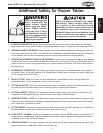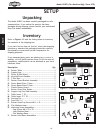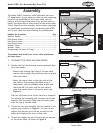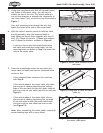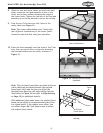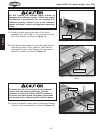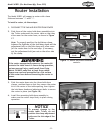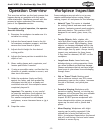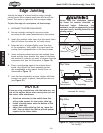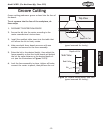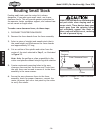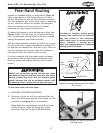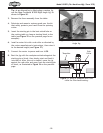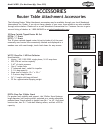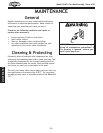
-13-
Model W1821 (For Machines Mfg. Since 3/10)
OPERATIONS
This overview outlines you the basic process that
happens during an operation with the router
table attachment. Familiarize yourself with this
process to better understand the remaining
parts of the Operation section.
To complete a typical operation, the operator
does the following:
1. Examines the workpiece to make sure it is
suitable for cutting.
2. Adjusts the fence boards close to the bit
for maximum workpiece support, and then
secures the fence boards in place.
3. Adjusts the bit height for the desired
cutting profile.
4. Adjusts the fence position to establish the
depth of cut.
5. Wears safety glasses and a respirator, and
locates push sticks if needed.
6. If using a reversible router, verifies that the
direction of spindle rotation is correct, and
then starts the router.
7. Holds the workpiece firmly and flatly
against the fence, and then pushes the
workpiece into the bit at a steady and
controlled rate until the workpiece moves
completely beyond it.
Important: The operator is very careful
to keep the workpiece firmly against the
table and fence during the entire cut.
For smaller workpieces or odd-shaped
workpieces, a zero-clearance fence or jig is
used.
8. Stops the router.
Operation Overview Workpiece Inspection
Some workpieces are not safe to cut or may
require modification before routing. Before
routing, inspect all workpieces for the following:
• Material Type: This router is intended
for cutting natural and man-made wood
products, laminate covered wood products,
and some plastics. This machine is NOT
designed to cut metal, glass, stone, tile,
etc.
• Foreign Objects: Nails, staples, dirt,
rocks and other foreign objects are often
embedded in wood. While shaping, these
objects can become dislodged and hit the
operator, cause kickback, or break the bit,
which might then fly apart. Always visually
inspect your workpiece for these items.
If they can't be removed, DO NOT cut the
workpiece.
• Large/Loose Knots: Loose knots may
dislodge during a cutting operation. Knots
can cause kickback and machine damage.
Choose workpieces that do not have large/
loose knots or plan ahead to avoid shaping
through them.
• Wet or "Green" Stock: Routing wood
with a moisture content over 20% causes
unnecessary wear on the cutters, increases
the risk of kickback, and yields poor
results.
• Excessive Warping: Workpieces with
excessive cupping, bowing, or twisting are
dangerous to cut because they are unstable
and often unpredictable when being
shaped. DO NOT process workpieces with
these characteristics unless you properly
square up the stock with a jointer and
planer.
• Minor Warping: Workpieces with slight
cupping can be safely supported if the
cupped side is facing the table or the
fence. A workpiece supported on the bowed
side will rock during a cut and could cause
kickback or severe injury.



